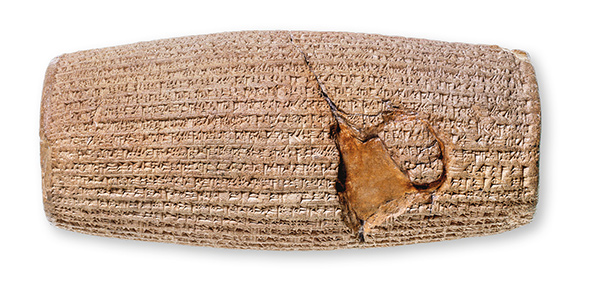“By the rivers of Babylon, there we sat, sat and wept, as we thought of Zion.
There on the poplars we hung up our lyres.”Psalm 137:1–2 [JPS]
While the words of the psalmist capture the longing of some Judeans to return from the Babylonian Exile, the prophet Jeremiah exhorted Judah’s exiles to build houses, plant gardens, marry and have families—to engage in activities that would assure the stability and continuity of life and community in a foreign land (Jeremiah 29:5–7).
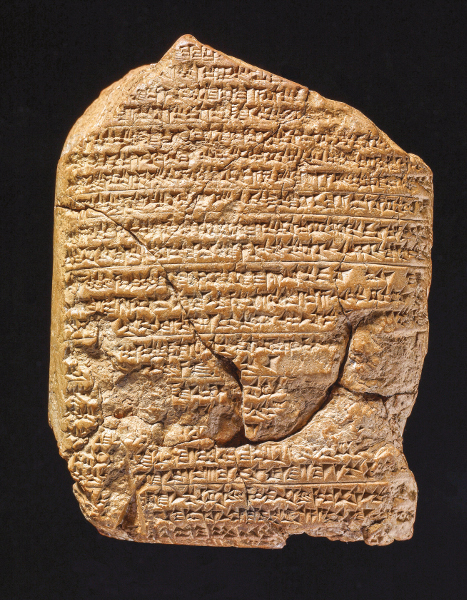
Recently published cuneiform tablets reveal fascinating aspects of Judean life under Babylonian and Persian rule.1 Written by Babylonian and Babylonian-writing scribes in service to the imperial administration, these sources inform our understanding of the social and economic standing of Judeans in the Mesopotamian landscape.
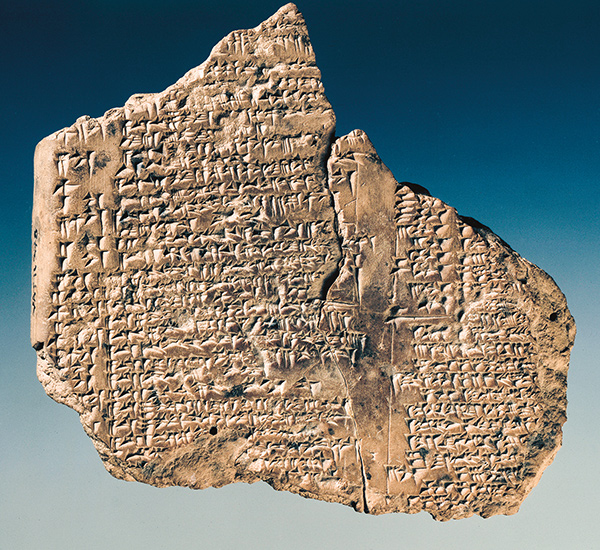
Nebuchadnezzar destroyed Jerusalem and the Temple in 586 B.C.E., but the Judean Exile had already begun as early as 597 B.C.E., with the removal to Babylon of Judahite king Jehoiachin, his mother, sons and “mighty men of valor, 10,000 captives and all the craftsmen and the smiths” (2 Kings 24:12, 15–16). The Biblical text continues, recording the cataclysmic destruction of Jerusalem, the burning of the “house of the Lord, the king’s palace and all the houses of Jerusalem” (2 Kings 25:9), and the subsequent removal of the population, along with the Temple furnishings and treasury. Jeremiah notes the dates of three subsequent waves of deportation, along with the numbers of people exiled in each: In Nebuchadnezzar’s 7th, 18th and 23rd years (597, 586, 582 B.C.E.), he deported 3,023, 832 and 745 people, respectively (Jeremiah 52:28–30).
The brief Babylonian record of the conquest of Jerusalem and Judah is narrated in the Babylonian Chronicle of the Early Years of Nebuchadnezzar, now housed in the British Museum, which acquired it in 1896: “The seventh year: In the month Kislev, the king of Akkad [i.e., Nebuchadnezzar] mustered his army and … encamped against the city of Judah, and on the second day of the month Adar he captured the city (and) seized (its) king. A king of his own choice he appointed in the city, (and) taking the vast tribute he brought it into Babylon.”2
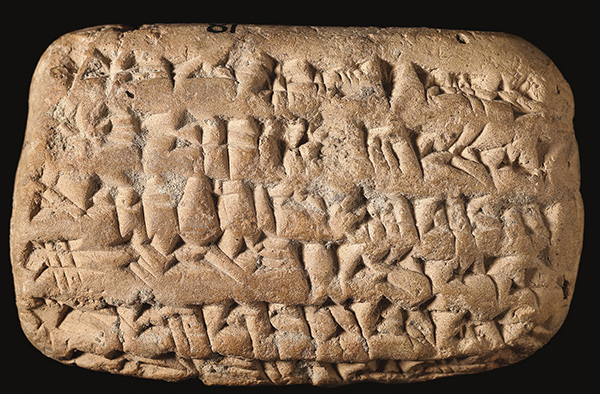
Both cuneiform and Biblical evidence thus corroborate that members of the Judahite court were exiled to Babylon and contribute to an understanding of their status there. The Bible tells us that Evil-Merodach (Babylonian Amēl-Marduk), son and successor of Nebuchadnezzar, released King Jehoiachin from prison, elevated him above other captive kings, and provided him with a daily food allowance (2 Kings 25:30; Jeremiah 52:31–34). This Biblical notice finds support in cuneiform ration lists excavated in Nebuchadnezzar’s South Palace, not far from Babylon’s famed Ishtar Gate.3 These texts preserve the names and titles of Levantine kings and high officials deported along with Jehoiachin. The ration texts confirm the diverse origins of deportee populations; Judeans as well as Egyptians, Philistines, Elamites, Lydians, Ionians, Medes and Persians received monthly disbursements of grain and oil. This admixture of nations is also reflected in the eight-sided clay prism known as the Hofkalender, or (imprecisely as the) Court Calendar, which lists the many provincial and imperial officials obligated to provide financial and material support for Nebuchadnezzar’s restoration of the Old (or South) Palace in Babylon, in which the aforementioned ration texts were preserved.
A small receipt in the archives from Sippar, now in the British Museum, confirms delivery of 1.5 mina of gold, owed by a certain Nabû-šarrūssu-ukīn to the temple of Marduk. This transaction occurred in 594 B.C.E., soon after Jehoiachin’s deportation from Jerusalem. This Nabû-šarrūssu-ukīn can be identified with Nebosarsekim (
Outside courtly circles, the lives of ordinary Judeans in Babylonia were documented in some 700 texts excavated at Nippur in the late 1800s.5 They record the activities of a family of businessmen, descendants of an entrepreneur named Murašû. Through assembly, sublease and, sometimes, foreclosure of parcels of land, members of the family profited from barley and date agriculture.
In the family contracts, Judeans appear primarily as witnesses in the Murašû texts. Witnesses typically belong to the same social circle as the transactions’ principals, so we can conclude that some Judeans (the witnesses) had achieved economic standing on par with the Murašû family. The mid-fifth-century B.C.E. date of the Murašû texts means that those Judeans belonged not to the Exilic generation, but rather to the period of Temple building that occurred under Ezra and Nehemiah’s direction back in Judah after their return.
The Judeans are identified in these, as well as other cuneiform texts, on the basis of their Yahwistic names (i.e., names constructed with a form of the Israelite divine name YHWH). Yahwistic names identify Judeans across the Babylonian landscape from the earliest days of the Exile.
In the city of Susa (Biblical Shushan, the setting of the Book of Esther), cuneiform texts dating to 494–493 B.C.E. record the presence of Judeans with Yahwistic names in the roles of royal courtiers and as children of royal courtiers. These texts record loans of silver exchanged between different members of prominent Babylonian families on their visits to Susa, trips that may have been made for the purpose of an audience with the king. Thus, we know that the Judeans interacted, in specific, limited ways, with members of the Babylonian economic elite.
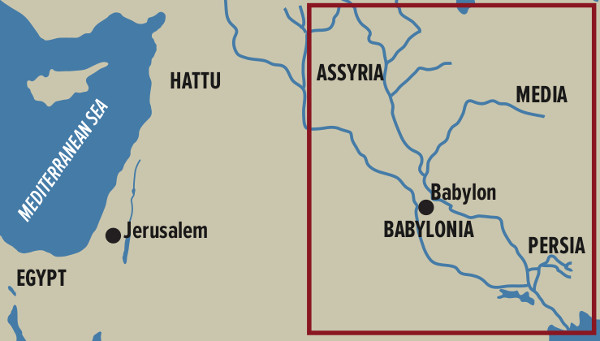
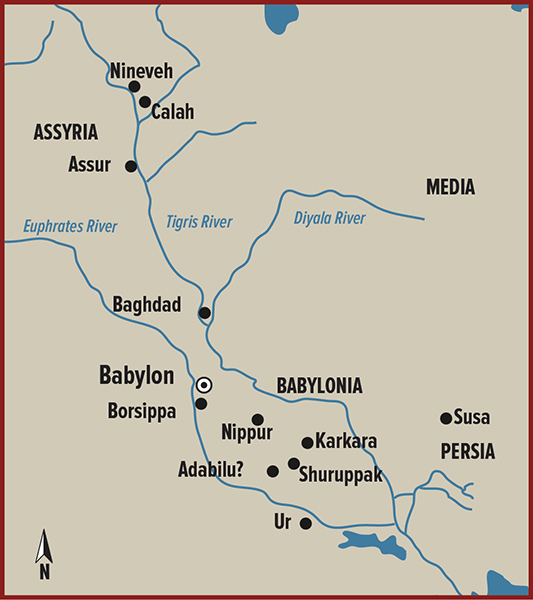
In Sippar, on the Euphrates River north of Babylon, a small number of Judeans with Yahwistic names appear with the designation “royal merchants.” These individuals belonged primarily to one family, in which there is otherwise widespread use of Babylonian names among its members. The most striking example is a Babylonian name attested in a marriage document of a daughter of a Judean royal merchant; her name Kaššaya is the same as one of Nebuchadnezzar’s daughters. The social designation and the use of Babylonian names attest to this family’s acculturation and adaptation to life in Babylonia.
A settlement called “Judahtown” (Babylonian āl-Yāḫūdu) was unknown until the 1999 publication of a single administrative texta written there in 498 B.C.E.6 Since then a group of 44 administrative and legal documents written in āl-Yāḫūdu has been identified and published.7 These texts, along with approximately 160 texts written in nearby towns, provide balance to the known documentation, now attesting to the lives of the lowly as well as high-born Judean and other West Semitic exiles, in rural as well as the previously documented urban landscapes, from the start of the Judean Exile to the time of the rebuilding of the Temple and beyond.
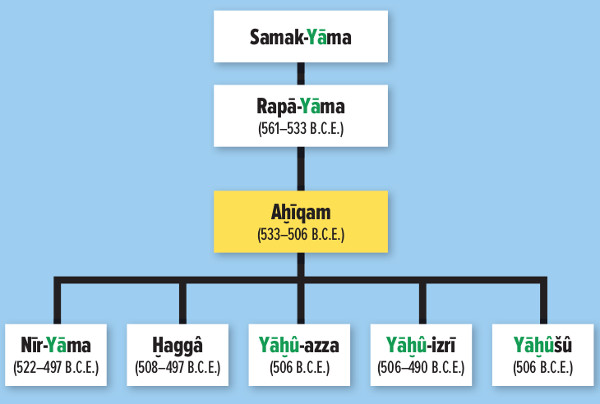
Two texts in the corpus, earlier than the first published Judahtown text, preserve a writing of the town’s name as ālu ša Yāḫūdu, “the city of the Judeans,” written in cuneiform as URU šá lúia-a-ḫu-da-a-a.8 This toponym thus confirms that Judeans were the primary inhabitants of that settlement; it is but one of several that reflect the demographic profile of towns Nebuchadnezzar established in old and abandoned, or in newly created, settlements in the countryside, particularly in the area around Nippur,9 populated primarily with deportees from defeated lands. The new residents worked to reclaim these lands, and in exchange for their access to the land, owed military service and taxes to the state. The system served not only to extend the state’s control of agriculture, but also to integrate and acculturate foreign populations into the empire.
The dates of these earliest texts from āl-Yāḫūdu mean that there is now a nearly seamless continuum in documentation of Judean presence that extends from the destruction of Jerusalem through the early part of the reign of the Persian king Xerxes (the latest text in the corpus dates to 477 B.C.E.).
Near āl-Yāḫūdu lay other towns named for other individuals of West Semitic origin, for example: Bīt-Našar (the estate of Našar) and Bīt-Abī-râm (the estate of Abī-râm). The town of Nār-Kabara (the town of river Kabara) is of special interest, as the component Kabara parallels the name of the river Chebar, a place from which Ezekiel began to prophesy to his fellow captives, and which figures prominently in the Biblical book that bears his name: Ezekiel 1:1–3; 3:15, 22; 10:15, 20, 22; 43:3. On the Babylonian landscape, Nār-Kabara refers to a waterway extending through rural Babylonia to Susa, along which commerce was transacted.
Judeans of āl-Yāḫūdu inhabited the countryside and participated in the activities and business of agriculture. The record of the Judeans at āl-Yāḫūdu corroborates the depiction of Jeremiah’s words: “Build houses and live in them, plant gardens and eat their fruit. Take wives and beget sons and daughters; and take wives for your sons, and give your daughters to husbands, that they may bear sons and daughters. Multiply there, do not be decreased. And seek the welfare of the city to which I have exiled you and pray to the Lord in its behalf; for in its prosperity you shall prosper” (Jeremiah 29:5–7, JPS).
The continuity and success of the Judean community is apparent in the records of five generations of one family living in āl-Yāḫūdu. The contracts in which Aḫīqam is the central figure show him, his father, Rapā-Yāma, and his sons to have been involved in rentals of land and date gardens, deliveries of grain and dates, collection of taxes and the acquisition of cattle for a plow team for efficient cultivation; marriage and death of family members are also referenced. Although Aḫīqam’s name is West Semitic, but not positively identifiable as Judean, his father and several sons bear Yahwistic names identifying them as of Judean descent.
Samak-Yāma, Rapā-Yāma’s father, never appears as an active participant in the āl-Yāḫūdu texts, but he is mentioned in five texts dating from 561 to 533 B.C.E. This chronology suggests that Samak-Yāma was born either in Judah or in Babylonia shortly after the deportation. His son, Rapā-Yāma, is primarily occupied with deliveries under the management of royal officials. Rapā-Yāma’s obligation to deliver barley on the estate of the rab mūgi, the Babylonian official known in Hebrew as rab mag in Jeremiah (Jeremiah 39:3, 13), illustrates the early interaction of Judeans with Babylonian administrators and administrative practices.
Documentation of Rapā-Yāma’s activity ends following 532 B.C.E., at which time his son, Aḫīqam, succeeds him in business and assumes his father’s role, even repaying some small debts remaining at the time of his father’s death. Some of these texts post-date the first year of Cyrus’s rule, when Cyrus (according to the narrative in Ezra 1:1–3) issued the proclamation that authorized Judeans to return and rebuild the Temple in Jerusalem.10
Aḫīqam’s business activities presented risk as well as potential for profit, as is evident in his contribution to a joint venture to build a plow team. Against the considerable expense of bringing together two oxen, two farmers, as well as the seeder plow and seed necessary for efficient and intensive grain agriculture, Aḫīqam and his partner also stood to share in the profits. Aḫīqam’s business acumen is seen in his exchange of a donkey mare for an ox and the payment in silver made to compensate for the differential value between the animals; the expense incurred contributed to Aḫīqam’s building a stock of animals that could be leased in future profit-making ventures. All of these mark him as an entrepreneur, interacting with the Babylonian population in and around āl-Yāḫūdu.
Small details suggest that Aḫīqam achieved a modicum of standing in the Babylonian economy. Some debts owed to him are repaid in “the measure of Aḫīqam.” It was common practice for a significant landholder to collect payments of commodities in a standard 6-liter measuring utensil marked with his name, an external indication of his authority. Records of business transactions between Aḫīqam and Banā-Yāma son of Abdi-Yāḫû (their Yahwistic names demonstrate the two written forms of the name of the Judean deity) indicate a network of relationships between members of the Judean community at Judahtown. Both men were landholders and sufficiently prominent to require repayment in their named measuring vessels; their comparable status shows that the lands at and around Judahtown could and did sustain agriculture beyond meager levels. The size of one of Aḫīqam’s obligations due to royal officials, four minas of silver, far exceeds the productivity of local agricultural activity. This, together with evidence of his connections with individuals outside the immediate area of āl-Yāḫūdu, and with members outside of the Judean community, establish that the scope of the family business expanded well beyond that evident in documentation of his father’s transactions. Aḫīqam continued to be active until 507 B.C.E.; documentation written in 504 B.C.E., following his death, substantiates his entrepreneurial success. On his death, his assets were divided among five known sons.
Aḫīqam’s family is representative of a pattern that must have been repeated many times and which may well have contributed to the continuity of the Jewish community that, generations later, produced the Babylonian Talmud. Although the evidence for Judeans on the Babylonian landscape, from the time of the Exile through the Persian period, remains scattered over time and topography, the cuneiform sources substantiate many of the brief notices preserved in the Bible.
MLA Citation
Footnotes
1.
André Lemaire, “The Universal God,” BAR 31:06.
Endnotes
1.
Laurie E. Pearce and Cornelia Wunsch, Documents of Judean Exiles and West Semites in Babylonia in the Collection of David Sofer, CUSAS 28 (Bethesda: CDL Press, 2014).
2.
A.K. Grayson, Assyrian and Babylonian Chronicles (Winona Lake, IN: Eisenbrauns, 2000), p. 102.
3.
E. Weidner, “Jojachin, König von Juda, in babylonischen Keilschrifttexten,” in Mélanges syriens offerts à M. René Dussaud (Paris: Paul Geunther, 1939), pp. 923–935.
4.
David Vanderhooft, The Neo-Babylonian Empire and Babylon in the Latter Prophets (Harvard Semitic Monographs 59; Atlanta: Scholars Press, 1999), pp. 149–152.
5.
Now housed in the University Museum of the University of Pennsylvania, the Museum of the Ancient Orient at the Istanbul Archaeological Museums in Istanbul, the Frau Professor Hilprecht Collection of Babylonian Antiquities at the University of Jena in Germany, The Phoebe A. Hearst Museum of Anthropology at the University of California, Berkeley, and the British Museum, London.
6.
F. Joannès and A. Lemaire, “Trois tablettes cunéiformes à l’onomastique ouest-sémitique,” Transeuphratène 17 (1999), pp. 17–34.
7.
Pearce and Wunsch, Documents, p. 28; Cornelia Wunsch, with collaboration of Laurie Pearce, Judeans by the Waters of Babylon. New Historical Evidence in Cuneiform Sources from Rural Babylonia in the Schøyen Collection, Babylonische Archive 6 (Dresden: ISLET, forthcoming).
8.
Pearce & Wunsch, Documents, p. 28; Wunsch, Judeans.
9.
R. Zadok, “The Nippur Region During the Late Assyrian, Chaldean and Achaemenian Periods Chiefly According to Written Sources,” Israel Oriental Studies 8 (1978); I. Eph‘al, “The Western Minorities in Babylonia in the 6th–5th Centuries B.C.: Maintenance and Cohesion,” Orientalia 47 (1978), pp. 74–90.
10.
There is no cuneiform evidence of such a proclamation in the reign of Cyrus or of any other Achaemenid king. Claims that the Cyrus Cylinder [BM 90920+NBC 2504] does so are unfounded. As a typical building inscription, the barrel-shaped document touts the work authorized by Cyrus for the restoration of ancient shrines in the eastern and northern regions of Mesopotamia. For a recent translation, and a discussion of the place of the Cyrus Cylinder in the historiographic program of the Achaemenid empire, see P. Michalowski, “The Cyrus Cylinder,” in M. Chavalas, ed., Historical Sources in Translation: The Ancient Near East (Oxford: Blackwell, 2006), pp. 426–430. For an important, earlier study on the programmatic nature of the cylinder, see A. Kuhrt, “The Cyrus Cylinder and Achaemenid Imperial Policy,” Journal for the Study of the Old Testament 25 (1983), pp. 83–97.


